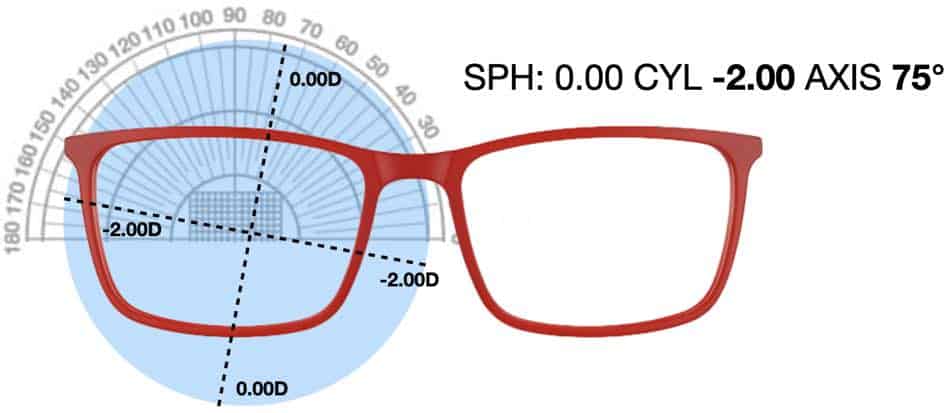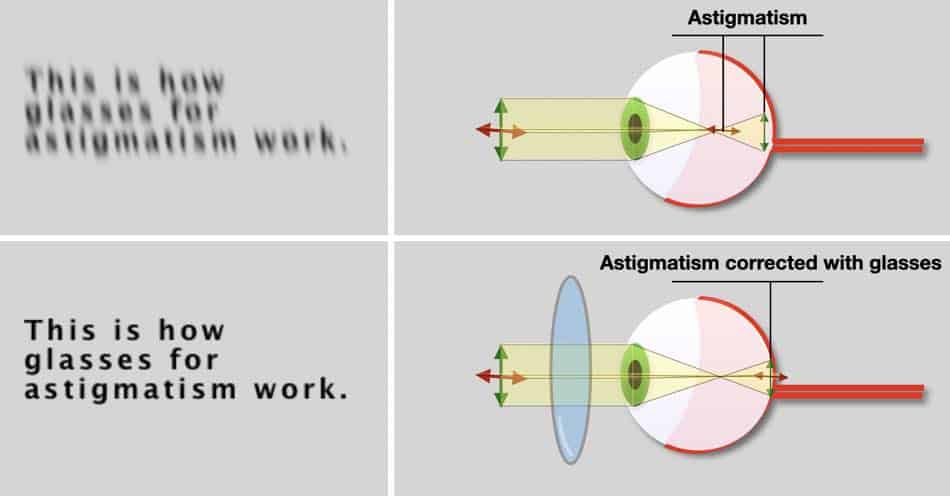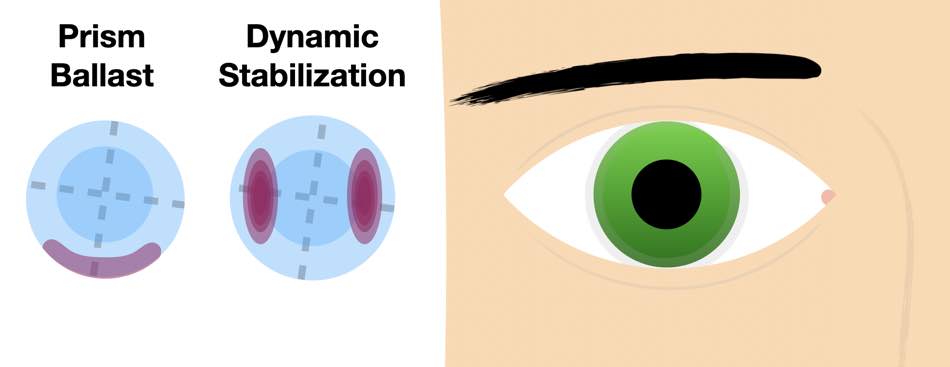Here in this article, you will learn about lenses for astigmatism how they work and what the difference is compared to a lens that corrects nearsightedness or farsightedness.
Lenses for astigmatism work by having an uneven lens power distribution throughout the lens design. This converges the light rays in differently in two of the four meridians and therefor produces a clear image for the person wearing the lenses with the correction for astigmatism.
In the picture below on the left side, you can see a typical spherical lens that has no correction for astigmatism. The shape of the lens also indicates that because the thickness of the lens’ edge is the same on every part of the edge.

But if you pay attention to the picture on the right you will notice a change in thickness and in power-distribution if you compare the meridians. The bigger the difference in the meridians the higher the astigmatism of the lens will be. The curvature of the left lens is also distributed evenly and on the left astigmatic lens, it is not. This is indicated by the hash line.
The difference in curvature changes the position of the focal points in the eye. If the wearer of lenses has a big astigmatism he or she has two focal points positioned in the eye that produce a blurry image. But when glasses with lenses for astigmatism are worn those focal points will both positioned on the retina. The outcome is a a clear image.
For this perfect outcome two things need to be exactly in place.
- Astigmatic lens power (CYL)
- Position of the the lens in front of your eyes (Axis)
Most wearers of lenses with an astigmatic prescription need a horizontal for the axis or CYL value. This means the axis in the lens need to be positioned at 0° or 180° (±15°). Then you have also the vertical position (90° ±15°) and the oblique ones (45°±15°). Lenses for astigmatism only work when the axis is positioned correctly. The higher the CYL value the more precise the lenses need to be rotated in the perfect position.

This is fairly easy when we talk about a lens for glasses. Because the shape of the frame leads to the stable fit of the lens in the frame. Here in the picture above you can see how this works. In the case of the prescription above the lenses need to be rotated and placed in a certain position. Then I as an optician know how to grind the mill the lens to the perfect shape with a CNC machine.
In the picture below I made an illustration for you how the paths of the rays change in the eye when glasses are worn with astigmatism or not. Astigmatism always splits up the image into two different parts. The higher astigmatism is the bigger the distance between those parts will be.

How Contact Lenses Work With Astigmatism
Compared to lenses for glasses that correct astigmatism contact lenses need other ways to be placed in the right axis of your eye. Lens manufacturers, therefore, have found different ways on how astigmatic lenses work on your eye.
The prescription needs to be placed in a stable position. This is achieved with a change of the thickness left and right adjacent to the optical zone or below it. In the picture below you can see the different areas of the astigmatic contact lens design. The darker blue illustrates the optical zone. The lighter blue just stabilizes the contact lens on your eye. And the purple areas illustrate the thicker areas.

As the lids close and open it rotates the contact lens in the right position by pushing against the thicker areas of the lenses. This is called dynamic stabilization. In contrast to the dynamic stabilization, added weight also leads to a more stable fit. Oftentimes those methods also get combined to correct astigmatism the right way on your eye.
Those methods oftentimes have their drawbacks. Depending on how the lids are structured and how tight they are on your eye they might not lead to a satisfying fit. Especially when astigmatism is higher slight rotation of the lens produces a subtle blur. Only when the lens rotates back in the right position optimal visual acuity with the toric lens designs (contact lenses for correcting astigmatism) is achieved.
This is especially true for a regular astigmatism which most people have in their prescription. However in some cases a special contact lens need to be placed on an eye with an irregular astigmatism. You can think about this as there are many different values of astigmatism on the cornea which can not optimally corrected with normal contact lenses nor with glasses.
In such a case a rigid permeable contact lens oftentimes is the best choice to correct irregular astigmatism. Those lenses even out the irregularities on the eye because the space between the cornea and the eye gets filled with the tear film. Normal contact lenses in comparison sit directly on the eye with less space between the cornea and the eye.
Which Types of Astigmatism Can Be Corrected With Lenses?
Every type of astigmatism can be corrected with contact lenses. There are regular types of astigmatism you can also correct with glasses and there are irregular ones that only work with contact lenses. When irregularities on your cornea minimize your visual acuity rigid gas permeable contact lenses will give you a much clearer image.
In my optical shop for example we fit the little ones and the bigger scleral contact lenses. Both can work great with irregular astigmatism.
How Long Does It Take To Correct Astigmatism With Glasses?
The correction of astigmatism happens as soon as you put the glasses on. This is the most common case. In seldom cases, wearers of glasses for astigmatism perceive objects in an askew way. When this happens the glasses need to be worn for a few weeks until you perceive the objects in a straight way back again.
If you want to know more about why you might perceive objects in an askew way with your astigmatic correction I wrote you another article here.
What Type of Glasses Are Used for Astigmatism?
In most cases nearly every type of glasses can be used to correct astigmatism. When it comes to a prescription higher than 1.50D of the astigmatism free form lenses might give the wearer a wider clear field of view.
Those lenses can be fit in every frame. In some cases when the prescription is as high as 6D with astigmatism the lenses might be available only in a bit smaller diameter. So in such a case extremely big frames could not be used. One question I often get as an optician is the following:
Is astigmatism with 0.25, 0.50, or 0.75D bad?
No astigmatism, in general, can be corrected very effectively corrected with glasses or contact lenses. Most people will have a prescription with astigmatism up to 0.75D even if they do not wear glasses or contacts.
I hope you found the information you needed about how lenses for astigmatism work.
I wish you a great day.
